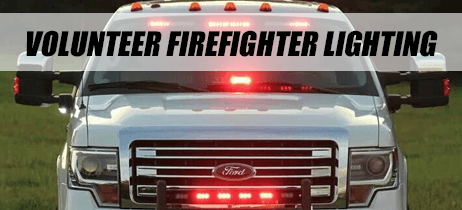What are the requirements for a firefighter to use POV lights
Posted by Extreme Tactical Dynamics on Jul 18th 2019

In the fire service, every second counts. Whether you're rushing to rescue a family from their wrecked vehicle or trying to save their property from a house fire, you know that there is no time to waste.
That is why firefighters keep everything at the ready, keeping pagers and radios charged up, properly storing equipment and turnout gear for rapid deployment, and studying their districts to know where every road, hydrant, and resource is located.
The biggest barrier to response time is usually traffic. Clearing other vehicles from your path is essential to getting to the station quickly and getting apparatus out the door and on the way to the incident. That is why so many volunteer, paid-on-call, and off-duty personnel utilize firefighter pov lights to improve their response time.
As a result, one of the first things new personnel want to do is to shop for firefighter lights, but before you invest in this equipment, you need to make sure you are meeting the necessary requirements.
State Laws
The 50 states have 50 different sets of laws governing the use of firefighter emergency lights. Never assume that you know your state's laws without reading them yourself, and if you move to a new state, be sure to review its requirements as well.
We've made both steps easy for you by gathering the laws of all 50 states into a single page; just click on the map to explore summaries and find links to full legislation. Once you know what is required and what is permitted, you'll know exactly what equipment you'll have to buy to be in compliant with the law.
Local Ordinances
Cities, counties, towns, and parishes are all free to institute additional requirements for pov lights, as long as they are no less restrictive than those of the state. There may be local conditions that have led to variations in when or where lights may be used, or by whom.
These ordinances can carry as much weight as departmental regulations or state laws, and you can create a negative image for your department if you recklessly ignore them. After all, you're more likely to interact with the local legislators who implement city laws than with the state legislators who created those regulations, so it's not only a good legal move, it's also a good public relations move.
Department Policy
Even if you are fully compliant with all relevant laws, there may still be policies in your department that regulate the use of firefighter pov lights, including
LED fire lights. These policies can vary widely from department to department, based on local situations. For example, some departments do not permit the use of emergency lights if you are responding from outside your own district.
These standards have been created with the experience and judgment of your department's senior people. Just as you trust them on the training ground and on a fire scene, you can trust that the decisions about pov policies are made with everyone's best interests in mind.
Your department may have a probationary period for new members that must be successfully completed before they can use lights. Others may restrict light use to officers or engineers only. Talk to your chief or other designated officer to get a copy of the department's policy, and learn the exact regulations before you make the first "code 3" run.
Appropriate Training
Of course, the first thing you'll have to do is complete appropriate training. The use of pov emergency lights puts you in a different class of vehicles on the road, so it is vital that you understand defensive driving for emergency vehicles. Be sure that you have completed all the required training before purchasing equipment.
This brings us back to laws; in some states, your pov carries the same legal standing as the apparatus you'll soon be riding in, but in others, the light is considered a request for the courtesy of other drivers.
Firefighters have lots of tools in their toolbox, but none of them can help if you don't arrive in a timely fashion. Saving time in response means more than just having the hose properly loaded and all the SCBA tanks full. It also means saving those valuable seconds and minutes on the road.
The best way to get those cars and trucks to yield is to use a powerful pov lighting setup to clear traffic on your way to the station, but the only way to get the right equipment and to use it in the right way is to understand all the various regulations and laws that impact your use of pov lights, and to get proper training in how to operate your vehicle when using them.
Study the requirements of your department, your community, and your state, and then equip your vehicle in compliance with those requirements. Only then will you be prepared to respond rapidly to those in need.
 Facebook
Twitter
Google+
Instagram
YouTube
Facebook
Twitter
Google+
Instagram
YouTube

